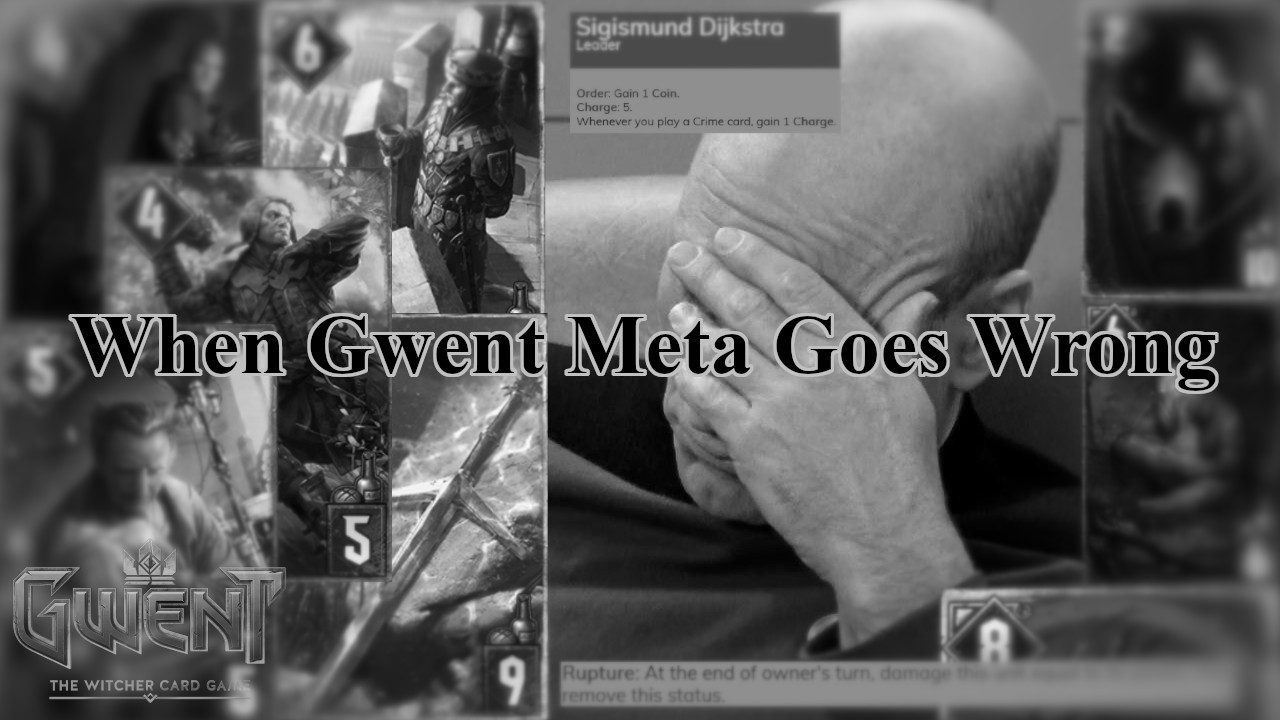Introduction
History tends to repeat itself in various disguises. By exploring Gwent metas in a retrospecitve manner it is possible to see some common motifs determining its character.
In this article we would classify those common motifs. We would concentrate on metas regarded as unhealthy and try to go down the roots of all evil.
Update May 15 – added Meditating Mages, clearified VWM and Relicts description
Round 1 Carryover Abuse
Perhaps one of the most annoying motifs, not necessarily unhealthy. It usually arises when a card establishing strong carryover after Round 1 is just introduced to the game and not balanced well enough.
In the current, 10.4/10.5 Gwent version, this strong R1 carryover card is Aerondight. Be sure to check out Pajabol’s expalanation of the issue. On top of tremendous carryover possibilities, this card is polarized with respect to coin:
- blue coin has some value guaranteed
- red coin needs to outtempo opponent soon to develop carryover
Round 1 course and drawing necessary resources is then what decides the game outcome in a great deal.
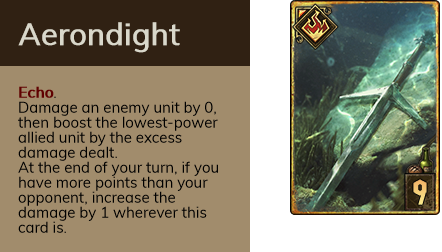
The motif of strong R1 carryover abuse appears very often in metas and decks regarded as unhealthy.
Another card granting great R1 carryover possibilities in the current Gwent meta is Melusine.
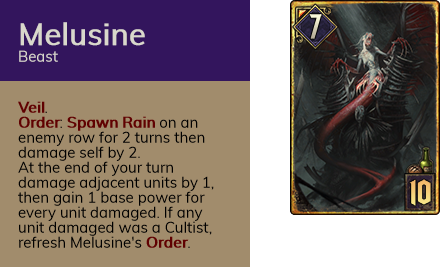
It is different to Aerondight in some vital practical aspects:
- Melusine could be directly countered with removal
- Melusine needs to be found in R1, while Aerondight should be found in R2 (but R3 is no disaster either)
- Both cards are susceptible to graveyard hate, but Aerondight would always need to be banished same round, which means trading down few points and 0:2 risk.
Cards like Melusine require extra tutoring. Melusine is not a real problem in the current Gwent state. Self-Wound – the main archetype making use of this card currently – is skill capped and unique to play.
In the tournament aspect, the risk of carryover abuses is even greater with controlled coin. An example of this would be blue-coin Imposter Practitioners deck used by many players on Gwent Open #1 of Masters 4.
Some cards introduced in the Forgotten Treasures expansion are strongly polarized carryover cards with little tempo:
- Highland Warlord – red coin
- Mutagenerator – red coin
- Aerondight – blue coin
Past Examples
- Meditating Mages
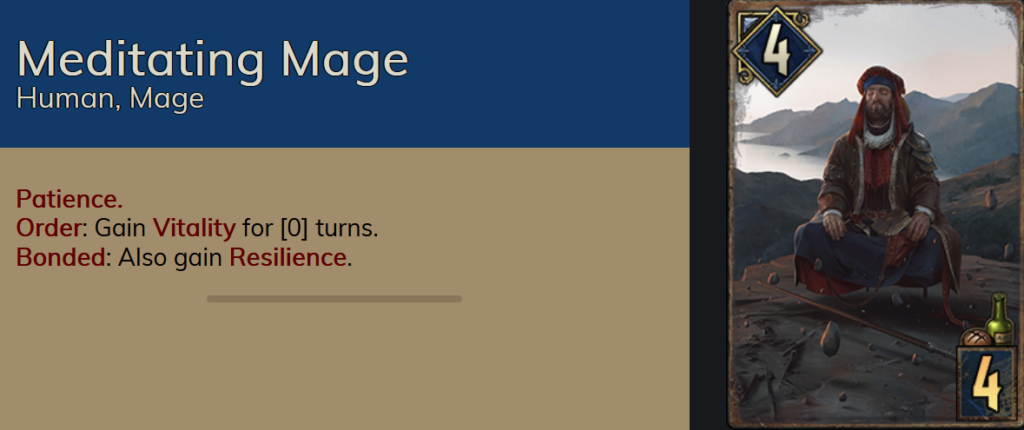
Meditating Mages (MM) were introduced in the last part of Price of Power expansion triptych: Harvest of Sorrow (Gwent 9.4.0). The card didn’t seem broken by itself at a first glance, but for sure possessed very strong bonded effect, especially for early rounds.
The problem emerged through the possiblility of all-in MM swarm with Tissaia. Tissaia played after using orders of all MMs in the same turn let carryover to be kept for all 3 rounds. Most imporantly though, it rocketed setup of Patience payoff cards in R2 – Aretuza Adepts, who costed 4p at the time. Adepts were called ‘micro-Kolgrims’ at the time, with ‘micro’ part being a joke – no deck was able catch up to value of well set up Adepts even being few cards up if lacking tall removal. MMs often weren’t even clicked in R2 for R3 carryover to not lose Adepts boosts.
But for decks having multiple removal resources, MM matchup was extremely unpleasant, R1 draws dependent and complained about. Consequently, Shinmiri even made a Reddit post on how to combat them from unfavored position.
In the following patch MMs were power nerfed to 3 points, and Adepts provision nerfed to 5p. Since then MMs are niche in Swarm application.
- King Foltest

With Blue Stripes Commandos, King Foltest was capable of generating +4/+5 points of carryover per turn and similar tempo at the same time. The drawback of the deck was need of high consistency right in Round 1, which made it strongly polarized for blue coin with Cursed Scroll stratagem.
The King Foltest strategy is still playable, but got powercrept by other, more consistently performing Northern Realms decks.
- Ciri: Dash
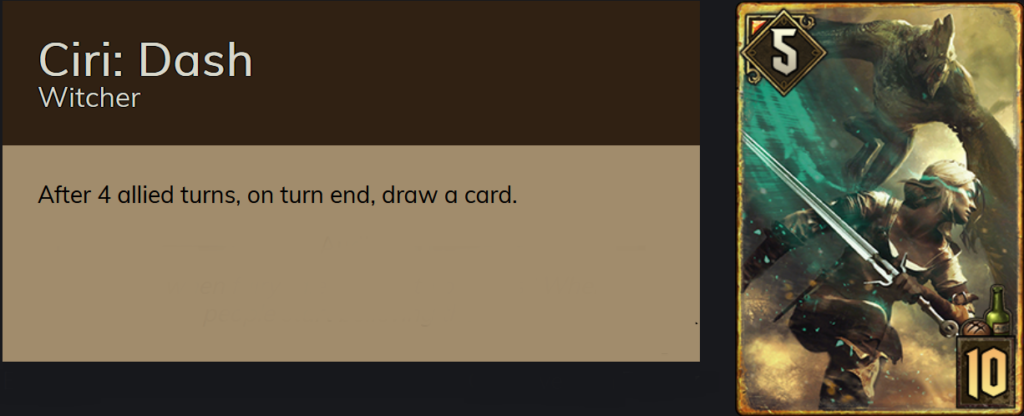
In Patch 7.1 the counter on Ciri:Dash was moved from 5 to 4 turns, which enabled going for card advantage even with Ciri played as the second card. Various decks abusing Ciri:Dash were tried (the idea was even revived in Freddybabes NR deck on Masters 1 finals!), but Keltullis became the staple one.
The deck was on the skillful side both when piloted and played against. The latter was very annoying for many players and tested deep understanding of the game, sometimes taking unusual lines like in this Pajabol vs Kolemoen classic.
- Dijkstra (Lined Pockets)
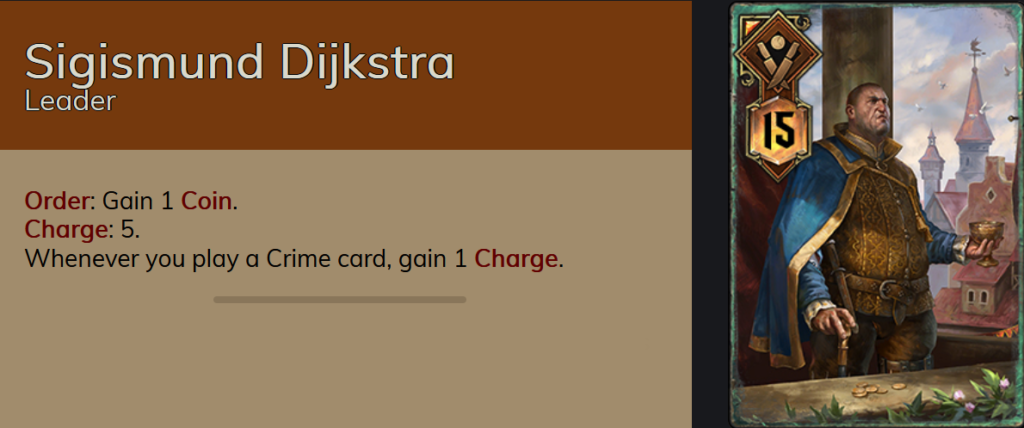
Dijkstra (Lined Pockets) leader ability at the moment of release was an example of both hard carryover abuse and unbalanced (overpowered) design. Being able to accumulate coins as charges (+1 for every played crime) led players to enter Round 3 with dozens of coins to spend at will. Letting alone Townsfolk Igor cancer decks which had the moment of glory at those times, simple Sea Jackal with full bank was a finisher of unmatched power.
Unbalanced Cards
Sometimes cards defined the meta not due to extraordinary effects or mechanics, but simply because of outstanding raw power.
Such cards would play a couple of points above meta Power vs Provision curve and simply feel unfair to face.
In the current 10.4/10.5 Gwent meta there is no cards strictly obeying this definition. Aerondight is very powerful and unbalanced, but limited by other players using same strategy, which leads to strong coinflip polarization rather than repeated outstanding value.
Overpowered neutral cards would lead to monotonous metas, trying to develop value from the same card in every faction (have a look at current Aerondight Nekker decks). The exception happens when only one or few factions are capable of making use of a neutral card (have a look at Ethereal story below) Overpowered faction cards would place one faction in a dominant position. It would lead to increased playrate, rising exponentially on high mmrs.
Past Examples
- King of Beggars
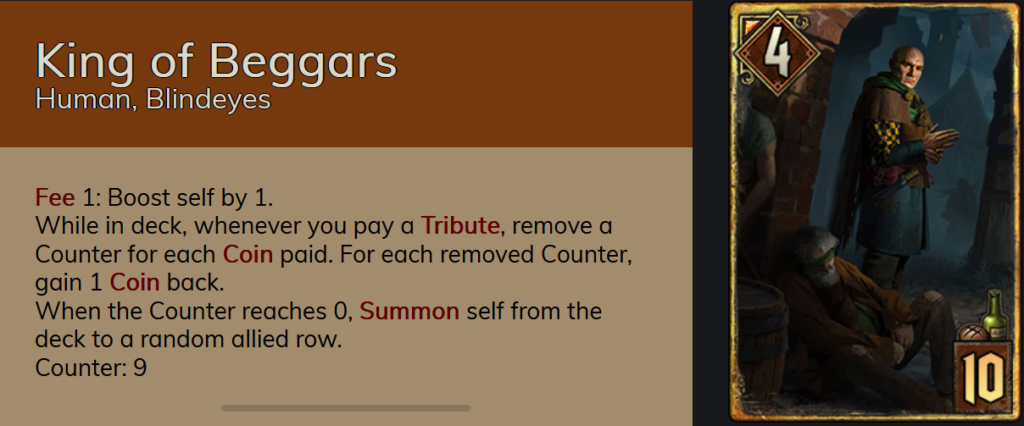
King of Beggars is the most recent example of a clearly overshot card. The KoB ability at the moment of release could as well be written as: “decrease your leader provision cap by 6 and distibute 13 points between your Tribute cards”. Many players called this card “13 points Roach”.
With KoB in the deck, Savolla played instantly as 8+12+4+9 = 33 points in one card given that the bank is full. Consequently Syndicate became a pointslam faction and due to coin spending KoB combined with Jackpot leader ability – easiest to manage coins in its history.
- Relicts
The second chapter of Price of Power triptych: Thanned Coup expansion, introduced perhaps the single most broken faction pack of cards in Homecoming history. With 6 power Self-eaters, Bloody Mistress and Mammuna at 10 provision, Relicts were outstanding in terms of power and omnipresent on ladder. Little skill was needed to achieve 2500+ results.
Caranthir into Mammuna combo played as raw 23 points for 9 provision, which was about 10 points above the curve. Self-eaters were hard to remove at 6 points base power and after just two splits and two relicts played became 11 point + 3 per turn engine. Finally Bloody Mistress with Caranthir and Idarran easily let achieve 200+ points scores when not countered. To add more, before quick hotfix, Mistress power was reset from 1 to 7 after transform when spawned with Caranthir.
Relicts meta is the most vivid example of bad balance during Masters 3 season.
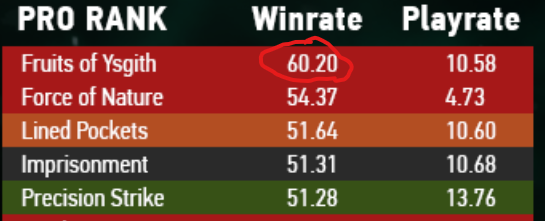
- Viy
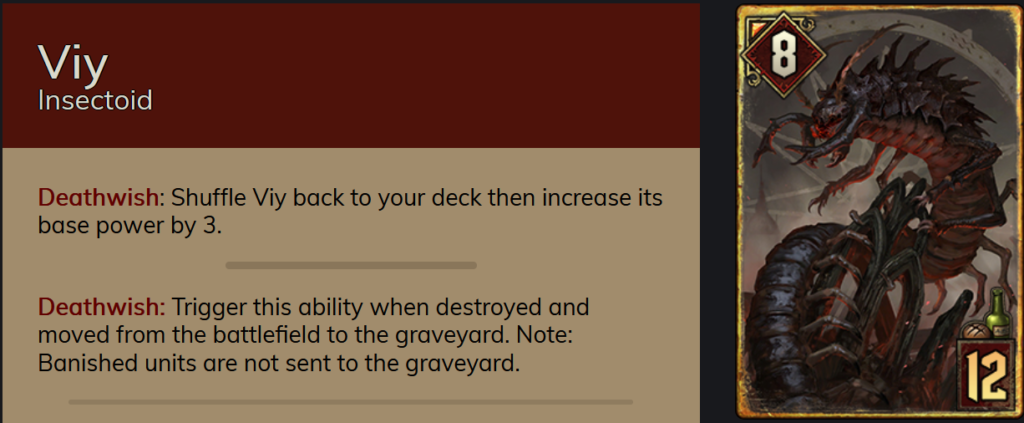
Released in Gwent 8.0 (Way Of The Witcher Expansion), Viy was a card with unique effect, forcing extremely linear deckbuilding focused on repeated tutoring and consuming Viy.
When working perfectly Viy was able to generate 200+ points in a long round, while not being an engine deck and having even more powerful short and mid-length rounds. Without tall punish, a single Viy played in R2 would usually require few cards from opponent to catch up.
Due to overtuned numbers, there were only 3 types of decks capable of challenging Viy:
– Extreme engine overloads (like movement ST)
– Lockdown Nilfgaard denying 90% of consumes
– Extremely teched decks with surprise multiple tall punishes or Geralt:Yrden
Viy meta is regarded as the most binary one in Masters 3 history. Lockdown and Viy were more than a half of the ladder and had extremely polarized matchups.
- Ethereal

Ethereal was introduced in Gwent 7.0 patch (Master Mirror Expansion) during Masters 2 season. The main and only application of this card proven to be combo with Fruits of Ysgith leader ability. Ethereal was effectively a +4 points per turn engine, transforming Fruit whenever spawned on the rightside. Most importantly though, this engine was unstoppable with meta cards – killing one Ethereal would still leave the second copy active, transforming next fruit into another Ethereal following turn.
Unlike Viy or Relicts, this card did not totally dominate the meta, in spite of crucial combo with leader getting discovered immediately. Ethereal Fruits deck was very strong and popular during last days of the season after TailBot’s success in Qualifiers with following list. Since then, many pro players launched impressive speedruns to 2600+ scores almost from scratch (check out interview with Demarcation).
Ethereal seemed too oppressive and tempo abusive at the time, which led to a rework next season. Since then card seen no play in Gwent.
- Viper Witcher Mentor
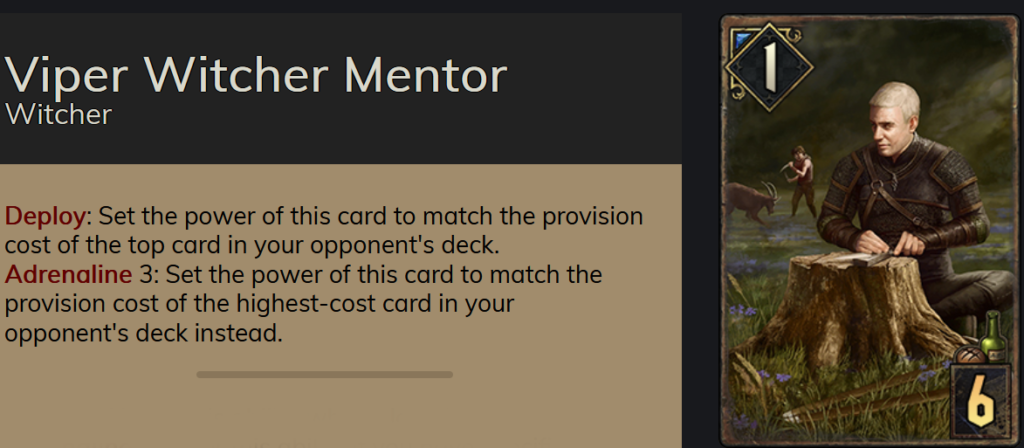
Two seasons after Way of the Witcher expansion hit, Viper Witcher Mentor got an accidental (unintended) buff from Adrenaline:2 to Adrenaline:3.
Luckily this is one and only example of a card balance change going in a strictly wrong direction, but consequences of this apparently small tweak were tremendous. Ladder experience got worsened by a lot with Viper Witcher Mentors playing often for 13+ points just beacuse of opponent missing a high-end card. Higher adrenaline value let such play happen earlier in R1, providing better reach and making it harder to tempo out opponent. Also sequencing in Cloggers decks became easier, indirectly buffing the deck even in later rounds by a few points.
VWM started to be played even outside its archetype for pure value.
- Warriors
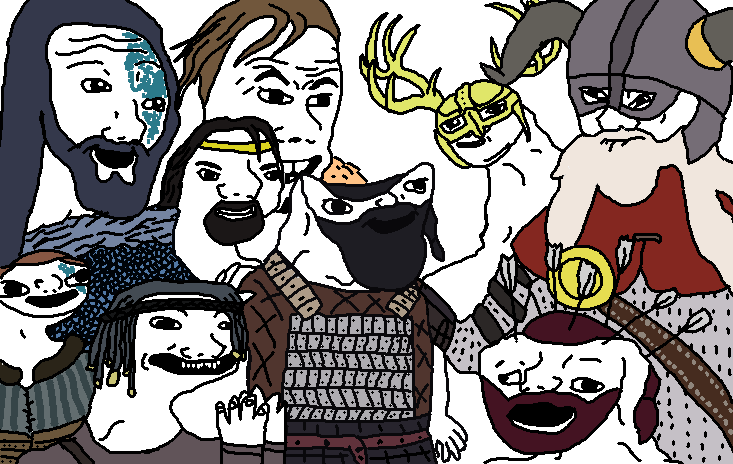
What was the single one most overpowered faction in the history of HC Gwent? By far Skellige after Master Mirror expansion! Relicts after Thanned Coup does not even come close!

Harald the Cripple easily played for 20+ points in a long round. Was it because he was too hard to kill at 6 power?… Well, why would you kill him if he is a perfect ressurection target for Second Wind leader ability?

Warriors and Relicts examples show that the most overpowered decks usually do not rely on memorable flashy combos, but are made up of few cards playing way above the power vs provision curve in an unconditional way. Both cases are not examples of wrong card design, but completely overshot balance on crucial cards.
Dominant Control Leaders
Not only control (removal) leaders are often understimated (Jackpot in Gwent 9.0 is the most recent example…), but the motif of strong control leaders defining the meta is very instructive and recurrent.
Damage abilities like Precision Strike, Guerilla Tactics or Reckless Flurry should be viewed as made of two parts:
- raw value – amount of damage + body in points
- removal value – effective value gained by removing opponent’s engines/setting up the board
Past Examples
- Milva + Guerilla Tactics
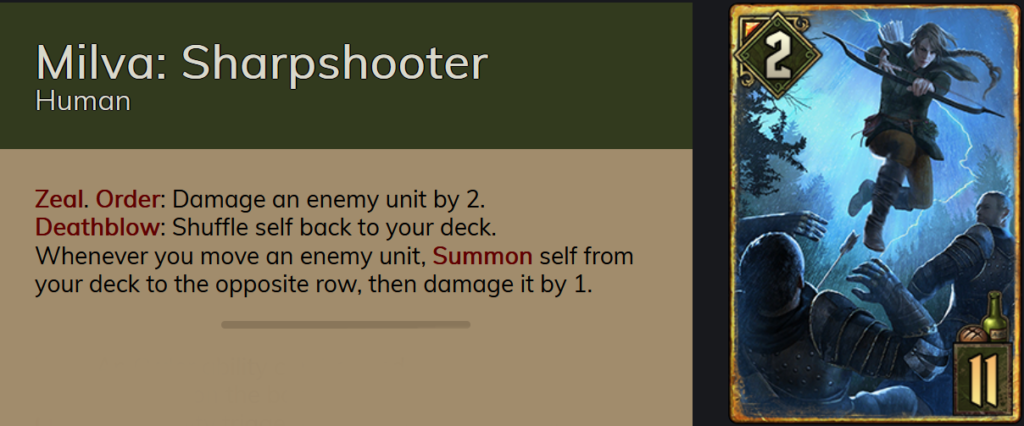
Milva: Sharpshooter was introduced to Gwent 9.6 with 2 points of damage on order. Combined with Guerilla Tactics movement, it was possible to remove a 5 power engine at will with a single leader charge.
Milva:Sharpshooter meta was an unpleasant experience for many players witnessing their whole board removed by a non-interactive card jumping back and forth between board and opponent’s deck.
- Early Homecoming
During early HC leaders like Eithné or Crach were capable of wiping out every card played on the board immediately or via group control tools like Schirrú or Scorch. Especially Eithné with renewing charges was regarded as oppressive for early HC power standards.

- Dettlaff (Blood Scent)

Introduced in Crimson Curse Expansion (Gwent 2.0.0), Dettlaff was a control leader with 12 points raw value. His power stood out to the point that a hotfix was issued in the release season.
Dettlaff is still regarded as the most broken leader ability in HC by many players.
Bronzes vs Golds Point Gap And Card Drawing Impact
Throughout Homecoming evolution following tendecies could be observed:
- bronze cards get closer in power to golds
- golds get closer in power to diamond
- the game center of gravity moved from R3 towards R1 direction
- defenders (“taunt” cards) were introduced
High point gap between golds and bronzes make draw RNG more important factor. During early Homecoming days, many games came down to fast passes in R1 and then card drawing contest in R3. This is not true anymore and the game is more dynamical but also more dependent on (obviously more random) draws in R1.
Defender mechanic deepened the threat-removal binarity – drawing ‘skill cap’ got elevated.
In the current 10.4/10.5 Gwent state I don’t perceive the game as extremely reliant on draws, but don’t think winning a game with missing any of crucial 20+ effective points golds is possible either (Golden Nekker, Zoltan:Warrior, Munro, Simlas, King Henselt, Ciri Nova in the correct moment in Aerondight deck…).
Past Examples
- Cloggers
The Demarcation tweet posted above was made before Cloggers were added to the game in the Way of The Witcher expansion 😉 Viper Witchers, Coated Weapons, Gorthur Gvaed and other tools inhibited opponent from drawing crucial cards unless those were found right in R1.
Personally I’ve never viewed cloggers mechanic as toxic by itself, but its payoff cards yes. Instead of punishing opponent for getting ‘skillfully deck manipulated’, Viper Witcher Mentors or Kolgrim punished missing particular cards (and opponent had no way to effectively play around such misses). Not drawing Masquerade Ball would mean 15 for 6 Viper Witcher Mentor, not drawing Korathi Heatwave or other tall punish – a loss to giant Kolgrim and so on…
- Feign Death Elves
Somebody could say not really a “past” example, but before 10.3 Gwent patch, the bronze to golds point gap in the Elves archetype was even bigger. The Elves deck was almost unbeatable when drawing perfectly on a red coin, but autolosing when drawing poorly on blue.
Binarities And Swinging Cards
Binary interactions: threat – removal, defender – purify, artifact – destroy, tall unit – tall punish (…) are to some extent essence of Gwent (and most card games) and not avoidable in 100%.
Sometimes though, the binary counter card has too high potential to not be included in a deck, even when the variance is very high and not a finding target may backfire.
An example of such card in 10.4/10.5 Gwent meta is Ornate Censer. When properly set up, the effective value of this card is equal to 2x power gap between highest and lowest unit on the board.
What should be noted immediately is how big the points are when the card works. Geralt of Rivia played on a 9 power unit (which could be for example lowest power unit boosted with Tactical Advantage in R1) plays as 12 points for 10. Okay value, but still may be not enough to win the round.
Censer used on the same unit with 1 power host on own side of the board is 2*8 = 16 points for 8 provision, which probably forces win on even. And opponent did nothing wrong by playing extremely high, neither did their archetype got naturally punished in any way. The point swing offered by this card is simply unhealthy, especially for 8 provision cost.
Past Examples
- Bomb Heaver (a.k.a. Watch Your Head Meta)
I don't wanna live in a bomb heaver universe anymore 😭😭😭😭
— Freddybabes (@Freddybabes) April 1, 2020
Curious what people think about the interaction between artifact removal and artifacts (particularly scenarios). Would you like to see something changed?
Bomb Heaver was the most clear cut example of binarity which made ladder experience less enjoyable. When Scenario cards were introduced, they were extremely overpowered and the only card which kept them in check (to some extent) was Bomb Heaver.
The card played effectively for a strong gold value when facing opponent playing Scenario (16+ points) and for around -3 points below par when target wasn’t there.
- Rupture

An example of unhealthy swinging card would be Tyrgvii Tuirseach after Master Mirror expansion release. The Rupture mechanic in the initial version damaged the affected unit by current rather than base power. It made Warriors not only overpowered, but also infinite reach deck on the red coin.
RNG Cards
In Gwent 10.4/10.5 RNG cards and leader abilities are not prevalent. The variance on meta cards, like Imperial Diplomacy or Lydia, is moderate and rarely game decisive.
RNG cards are great for memes. Also when low variance, they bring freshness and test improvisation skill on competitive level.
On the other hand, high variance RNG cards in competitive meta are extremely unhealthy – should be avoided and burn out with fire whenever arise.
Past examples
- Viper Witcher Alchemist


Spoiler: The card was reworked 6 months after this feedback and Open level games were decided by Alchemist 🙂 The effect was moved to another card: Spotter, because obviously its fine and only playing it via Location was troublesome 🙂
Not gonna lie, this one still pisses me off. No reason to keep an unhealthy card in any form even if it sees less play now – a game deciding Spotter from Diplomacy is only a matter of time at official tournaments. And no, it is not another Kingslayer, because the effect of hitting a top end card is twice as strong. The card still has potential to randomly play for 20+ points of carryover and unlike Ofiri Merchant, works in only one direction – could win game on the spot, couldn’t lose.
- Bribery
Bribery value naturally follows the powercreep so that it may seem autobalanced. In reality though, with many “20+” points gold cards printed (Fucusya, Simlas, Zoltan Warrior, Gerhart of Aelle…), the variance becomes higher and higher.
While obviously not played so much in Nova Nekker Aerondight meta, Bribery deserves a closer look before another meta shift.
Closure
Thanks for reading! I didn’t know it would be such a substantial article when started working on it. Nevertheless many themes were described only superficially.
If you have any questions or remember other common motifs and examples of ‘meta going wrong’ during Homecoming, feel free to contact me on Discord: [LGC] lerio2#7328.

